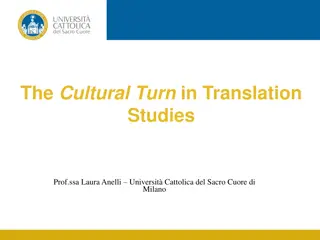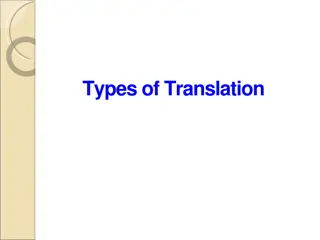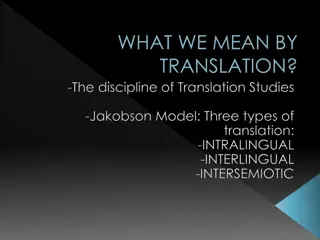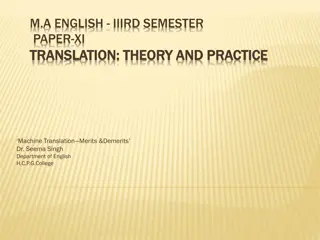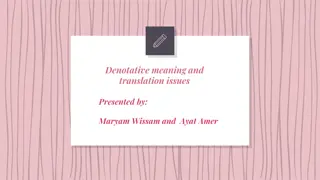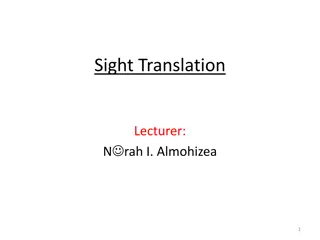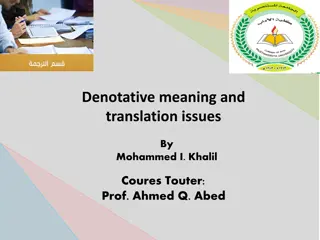Exploring Denotative Meaning and Translation Issues
Delve into the intricacies of denotative meaning and its implications in translation. Understand the nuances of polysemy and homonymy, along with the significance of synonymy in defining word meanings. Gain insights into the complexities of determining and translating the literal meanings of words.
Download Presentation

Please find below an Image/Link to download the presentation.
The content on the website is provided AS IS for your information and personal use only. It may not be sold, licensed, or shared on other websites without obtaining consent from the author. Download presentation by click this link. If you encounter any issues during the download, it is possible that the publisher has removed the file from their server.
E N D
Presentation Transcript
Denotative meaning and translation issues Presentation by: Farah jaafar Coures Touter: Prof. Ahmed Q. Abed
Denotative meaning and translation issues Translation is concerned with meaning. But, as has already become very clear, the term meaning is 1- elastic when applied to a whole text. and 2- indeterminate, especially This elastic and indeterminate of the meaning is true even of denotative meaning
Denotative meaning denotative meaning also known as ( cognitive, propositional or literal meaning) Denotative meaning :- is that kind of meaning that relates directly to the range of things (whether physical, emotional or more abstract) that are conventionally referred to by a word or phrase in a particular sense. e.g window ---> by convention refers to a particular kind of aperture in a wall or roof is a matter of denotative meaning.
So denotative meanings that are the central feature of dictionary definitions. In fact, words may, and typically do, have more than one denotative meaning. Clear ( a plain sky ) plain ( ) ) ( Obvious ( it is a plain case of forgery ) Unadorned ( a plain paper bag )
The situation in which a word has more than one different and distinct denotative meaning or, more technically, more than one sense is known as polysemy. Note :- 1. There are sometimes problems in deciding between cases where two uses of a word represent more than one sense that is, cases of polysemy and where the two uses in question are merely variants of a single overall sense. These need not concern us here, as they are not typically of great importance for translation.
2. There are also problems in deciding between what constitutes two senses of a single word and cases where two words happen to sound the same, This latter situation is known as homonymy. institution for the investment and borrowing of money side of a river Bank Again, these are not of great importance for translation
Synonymy Word or phrase that means exactly or nearly the same as another word. To define a denotative meaning is to specify a range covered by a word or phrase (in the relevant sense) in such a way that one knows what items are included in that range or category and what items are excluded. It is helpful to visualize denotative meanings as rectangles, because rectangles can represent intersections between categories.
e.g The expressions ( my mother The expressions ( my mother s s father & my maternal grandmother ) father & my maternal grandmother ) may be represented as two separate rectangles. The two ranges of denotative meaning, however, coincide perfectly: that is, in every specific instance of use, my mother s father and my maternal grandmother include and exclude exactly the same referents. This can be visualized as sliding the two rectangles on top of each other and finding that they are the same size and cover each other exactly.
Note :- Comparison of denotative meanings can also be made among expressions from two or more different languages. e.g maternal uncle and (Is one sense of the word ( cover exactly the same range of meanings and are therefore fully synonymous
Hyperonymy Hyperonymy- -hyponymy hyponymy * full synonymy is exceptional, both intralingually and interlingually. Even the nearest semantic equivalent for translating the denotative meaning of an ST expression usually falls short of being a full TL synonym. A simple example of this kind of failure is provided by a comparison between uncle in English and and in Arabic. e.g uncle might be a typical translation equivalent of the Arabic , Uncle in English lacks the technical associations of paternal uncle and maternal uncle and would therefore be preferred in many contexts in translating or , regardless of the translation loss involved.
From the point of view of denotative meaning, however, uncle has a greater range of meanings than or uncle and maternal , as uncle includes both paternal Uncle * It means that when there is no full TL synonym for a given ST expression (e.g. uncle ), the translator must look for an appropriate TL hyperonym or hyponym. Uncle Hyperonymy Hyperonymy- -hyponymy hyponymy ( superordinate) ( superordinate) hyponymy hyponymy
The relationship between uncle and and between uncle and is known as hyperonymy-hyponymy. An expression with a wider, less specific range of denotative meaning is a hyperonym (or superordinate) of one with a narrower and more specific meaning. An expression with a narrower, more specific range of denotative meaning is a hyponym of one with a wider meaning. Thus and are both hyponyms of uncle .
Particularizing translation and generalizing translation Translating by a hyponym implies that the TT expression has a narrower and more specific denotative meaning than the ST expression, We shall call this particularizing translation , or particularization for short . Uncle Particularizing translation In translating from Arabic to English, TT uncle is more general than ST ) or , ( omitting particulars given by the ST. We shall call this generalizing translation , or generalization for short. generalizing translation
Another example 1- where the context implies something that is typically referred to in more specific terms in the TL than in the SL thus, an issued by a military commander is likely to be an ultimatum rather than simply a warning or in the context of NATO raids on Kosovo is likely to be strikes or air strikes rather than attacks .
- 2 . Whatever the legal problems linked to NATO intervention, to which I myself have recently referred * recently is preferred to the denotative equivalent a few days ago mainly because it results in a less wordy overall phrase. Recently also allows the translator to use the present perfect have . . . referred , which adds a sense of immediacy and relevance to the statement; a few days ago would require the use of the past simple referred , which suggests more detachment.
Semantic overlap and overlapping translation when a word or phrase overlap in its meaning with another word. e.g . The distinguished British writer Robert Fisk recently described a concert in Belgrade.
the meaning of overlaps with that of concert. Some concerts are examples of those in which there are singing. Similarly, some cases of are examples of concerts; those that are organized in a formal way with musical players and audience. However, some concerts are not examples of those in which there is no singing. Similarly, some cases of are not examples of concerts; those, for example, in which the is not organized in a formal way with musical players and audience.
Note :- We shall call it partially overlapping translation, or partial overlap for short. Partial overlap is common and often unavoidable. It can apply to single words as well as to phrases or whole sentences. e.g a poem by the Syrian poet contains the line They attacked her like a young sparrow until they killed her
here overlaps in meaning with young. Some but not all spring sparrows are young, and some but not all young sparrows are spring sparrows (one could have a sparrow that was born in summer). Spring sparrow , however, is a problematic phrase in English; it does not have a clear meaning, and there is nothing in this overall context to make the intended meaning clearer in the English.
Near-synonymy and translation Near-synonymy is a case not of synonymy but of hyperonymy-hyponymy or semantic overlap, which comes near to being synonymy. e.g ( thin ) vs ( skinny ) we assuming the reasonableness of a statement She s thin but not skinny She s skinny but not thin we can't assuming the reasonableness of a statement
There is a very significant overlap between thin and skinny such that thin people are typically also skinny. Thin and skinny can accordingly be regarded as near-synonyms in English.
An example of near-synonymy involving a hyperonym-hyponym translated as angry where the definition of the Standard Arabic usage of reflects the definition of the colloquial usage of , means not just angry but angry with a degree of sadness . (i.e. sadly angry ). Arabic is thus technically a hyponym of English angry (as it excludes those cases of anger that do not also involve sadness). is, however, close enough to the meaning of angry to be considered a near-synonym of angry .
Arabic is thus technically a hyponym of English angry (as it excludes those cases of anger that do not also involve sadness). is, however, close enough to the meaning of angry to be considered a near- synonym of angry . Angry Angry hyponym Sadness , Sadness Not sadness





